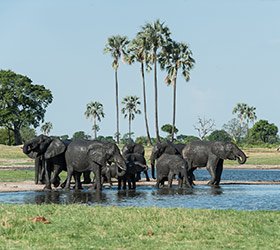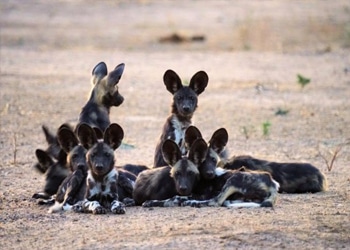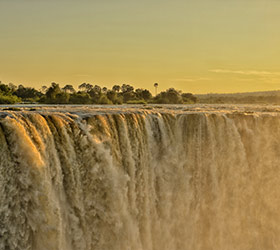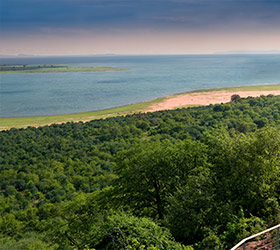Zimbabwe
All Destinations
Zimbabwe
Zimbabwe is a landlocked country in southern Africa known for its dramatic landscape, the majestic Victoria Falls and extraordinarily diverse wildlife, much of it within parks, reserves and safari areas.
Despite its political past and its economic challenges, Zimbabwe has kept intact its most extraordinary tourist credentials: dramatic landscapes under a perfect climate, friendly and welcoming people, a wide range of historical and cultural attractions, a number of thrilling adventure activities, and some of the best wildlife encounter worldwide. As stability to the country has returned, so too have the travellers and slowly but surely Zimbabwe is once again earning its reputation as the top Safari Destination of choice.
Good infrastructure make it relatively easy to move between different parks and enjoy different environments. Hwange National Park is just about one hour south of Victoria Falls, in the northwest corner of the country. Further South to Bulawayo Matobo Hills National Park is also easy to access. More difficult to reach but highly rewarding is Mana Pools and another great water-based safari experience is at Matusadona Park, on the Southern shore of Lake Kariba, between Victoria Falls and Manap Pools.
It is not only the dramatic landscapes teeming with wildlife, the beautiful national parks, rugged mountains and lush forests that make this country a prime safari destination. Zimbabwe is renowned in Africa for the high quality of its guides, and the standard of lodges. The decline in tourism in the past years in Zimbabwe provide even greater opportunities for unparalleled wilderness experiences, far from the safari highways known in South Africa, Kenya or elsewhere. In its national parks there is a high probabiilty of seeing several of the Big Five (buffalo, elephant, leopard, lion and rhino), as well as giraffe, cheetah, hyena, jackal, monkey, antelope. Zimbabwe is one of the last rhinoceros havens with both white and black rhinos. Other rare species to be found in Zimbabwe include the wild dog, nyala, the king cheetah and the samango monkey.
Adrenaline seekers will love bungee jumping and white-water rafting at the Falls, while adventurists turn to canoeing and walking safaris along the mighty Zambezi River. Culture vultures and historians will be enthralled by the bushman paintings at Matopos, the mysterious Ruins of ancient Great Zimbabwe and the stone sculptures in Harare.
Quick Facts
Capital
Harare
Population
16 million
Area
390,759 sq km (150,873 sq miles)
Major Languages
English (official), Shona, Sindebele
Major religion
Christianity, indigenous beliefs
Monetary Unit
Multi-currency system; US dollar and South African rand predominate
Flight time from London
15 hours via Johannesburg
Time Difference
GMT + 2
When to go
Nature has given Zimbabwe one of the finest climates in the world: it is warm without being oppressive with an average sunshine ranging from four to ten hours per day (and the sun shines 90% of the year!)
The dry season is from April to October when the whole country has very little rain. April and May are classified as mid-season. The rainfall leaves the vegetation very green and thick and Victoria Falls is at its mightiest. Temperatures can reach up 30°C (86°F) during the day, but the evenings and early mornings are cooler, and in Hwange it can drop to freezing at night, so warm clothes are required.
June to September are peak season, when prices are at their highest. June and July see warm days filled with sunshine, and cold nights as this is Zimbabwe’s winter. Wild dogs emerge from their dens and large herds begin to form around Hwange waterholes and along the Zambezi River at Mana Pools. In August, the temperatures rise with less ground water. The competition for water intensifies providing excellent photographic opportunities around water holes. Greater visibility, bigger herds – this is the height of the dry season resulting in great game sightings.
October is the driest months but expect extreme temperatures. Midday temperatures can hit the late thirties and nights are balmy. Water sources are at their most scarce, making this the best time for wildlife viewing. Botanists will enjoy the many flowering trees and bushes and there is an abundance of birds.
November is a transitional month with the arrival of the rain. The landscape is still dry with exceptional wildlife sightings, including African wild cats, bat eared foxes and the elusive aardvark. Afternoon thunderstorms bring welcome respite from the heat, evenings are warmer.
December to March is known as the green season. It is a time of abundance… births, babies and breeding (and predators), but note Mana Pools is closed during these months. Glorious photographic opportunities… great light, vibrant colours and few tourists. Temperatures average 20°C to 30°C (68°F to 86°F).
- J
- F
- M
- A
- M
- J
- J
- A
- S
- O
- N
- D
- High Season
- Mid Season
- Shoulder Season
Highlights
















Hwange National Park
Hwange National Park is about one hour south of the Mighty Victoria Falls, in the northwest corner of the country bordering Botswana. On the edge of the Kalahari Desert, it covers a vast 14,651 km² plateau, 1,000m above sea level, and features desert sand to sparse woodland, as well as grasslands and granite outcrops.
The flora of the park is mostly Acacia woodland underlain by Kalahari sands, which have blown across from the Botswana desert over many decades. The miracle of Hwange is the life brought to it from its 63 man-made waterholes, without which its natural arid climate would render it an unpopulated, sandy mopane forest. Rivers and their tributaries drain the north and north-west of the park and the far south, but there are no rivers in the rest of the park. Two years following its establishment as a national park in 1928, the borehole drilling project started in earnest, pumping calcium rich waters to the surface from 60 meters below ground level. Now, with 480 km of game viewing roads network connecting waterholes and outstanding animal concentrations, the park is easily accessible and the most visited park in Zimbabwe though thankfully not overcrowded – save for its 30,000 elephants!
But there is much more to Hwange than the elephants. All Zimbabwe’s specially protected animals are found here and it is the only protected area where gemsbok and brown hyena occur in reasonable numbers; added to which the population of the Cape wild dogs in Hwange is thought to be of one of the larger surviving groups in Africa. More than 100 different species of mammals and 400 species of birds fill this national park with life. Major predators include the Southwest African lion – whose distribution and hunting in Hwange is strongly related to the pans and waterholes – African leopard, spotted hyena and South African cheetah. It is not uncommon to come across good herds of buffalo and you may be lucky and see the magnificent sable or roan that live here too. The different habitats of the park, from wide open grasslands to thick forest, provide exceptional opportunities to see a great range of game on drives.







Mana Pools
Mana Pools National Park, centred on the mighty Zambezi River, has some of the most spectacular river scenery and game-viewing in the country.
Situated in the North of the country, Mana Pools is a superb wildlife reserve lying at the heart of an important conservation area, a large parks and wildlife estate that stretches from the Kariba Dam in the west to the Mozambique border in the east.
The name “Mana” means four in the local Shona language, denoting the four big pools surrounding the park’s headquarters, a veritable oasis for hippopotamuses, crocodiles, elephants and innumerable aquatic birds. It is a small park covering just 2,190km², but contained within there is an extraordinary density of wildlife, notably lions, leopards, spotted hyenas and of course elephants. This is also one of the very best locations in Africa for wild-dogs.
Over the millennia, the Zambezi’s meandering waters have been responsible for depositing the unusually rich soils that line the river across the area encouraging the creation of broad grassy floodplains and impressive stands of open mahogany and ebony forests. The river has formed islands, channels and sandbanks in the valley, enabled small ox-bow lakes to shape in the mineral-rich volcanic soils, which together contribute to the magnificent scenery of Mana Pools.
Mana Pools is renowned as one of the very best locations in Africa for walking safaris, including on foot approaches to larger wildlife including elephants and lions. Some of the guides here have been in the park for decades and have personal relationships with individual elephants and other animals. It is also famous for its epic canoe safaris along the Zambezi River, which can get rather exciting at times as the resident hippos can be quite unpredictable.
Mana Pools National Park was designated a World Heritage Site by UNESCO in 1984, even before Victoria Falls, the Great Zimbabwe Ruins, the Khami Ruins and Matobo Hills National Park.





Victoria Falls
The crowning glory of Zimbabwean natural beauty and known locally as Mosi-oa-Tunya or “Smoke That Thunders”, Victoria Falls was named in honour of the queen of England by David Livingstone, the first European to discover them in 1855.
A UNESCO Natural World Heritage Site, this 1700m wide waterfall drops up to 5 million litres of water every second 70 to 108 meters down into the narrow Batoka Gorge whilst sending giant spray clouds high into the air.
Beside the fantastic viewing of the Falls, the Victoria Falls bridge and David Livingtsone’s Statue, the destination offers a wide range of activities to distract the safari lovers from game viewing:
For those seeking an adrenaline buzz: bungee jumping from the Zambezi bridge, the gorge swing, the flying fox, and white water rafting trips downstream in the gorge all offer some of the most adrenaline drive activities in the world.
A number of operators offer flights over the mighty falls with microlights, light aeroplanes and helicopters.
Other activities on offer are horse-riding, elephant-riding, walking with Lions, canoeing or visiting the crocodile farm and diving with crocodiles.
More relaxing activities include rain forest walks, and sunset cruises which are a must.
Game drives are conducted in Zambezi National Park.
African traditional dancing, craft markets and gastronomy complete the cultural picture.




Matusadona & Lake Kariba
With 2,000 km of shoreline, Lake Kariba is the 4th largest man-made lake in the world and the 2nd largest in Africa. It was built to generate hydropower from the powerful Zambezi river and Nyaminyami – the River God.
There were many stories and even legends attached to the dam construction. Matusadona was proclaimed a non-hunting area on the 7th November 1958 before the dam was built. By the opening of its operations in 1959, as water levels rose dramatically, a huge rescue operation called “Operation Noah” had to be organized: it saved some 5,000 animals of 35 different species from drowning, but only on the Zimbabwean side.
Located on the shores of the lake, the Matusadona National Park hosts most of these animals who had to adapt to the initial flooding and annual fluctuation. Matusadona now has three distinct ecological areas: the lake and shoreline grassland; the Zambezi Valley floor, a mass of thick jesse and mopane woodland; and the Escarpment area of Julbernadia and Brachystegia woodlands. The Jesse/ Mopani area is sparsely grassed, but provides habitat for browsers, most notably the black rhino. Elephants range throughout the Park, seeking the shade of the Jesse in the heat of the day.
With a ready supply of regenerative grasses as a source of food and an abundance of water from the lake, buffalo, waterbuck, zebra, and even impala have thrived and with them the predators. Matusadonh a is an Intensive Protection Zone (IPZ) and home to several relocated rhino’s. The lake is teeming with massive Nile crocodiles, herds of swimming elephants, and the lake shores of Kariba include sightings of the big five. The bird life is exceptional with a very large population of fish-eagles, and the aquatic animal population is equally interesting.
















Hwange National Park
Hwange National Park is about one hour south of the Mighty Victoria Falls, in the northwest corner of the country bordering Botswana. On the edge of the Kalahari Desert, it covers a vast 14,651 km² plateau, 1,000m above sea level, and features desert sand to sparse woodland, as well as grasslands and granite outcrops.
The flora of the park is mostly Acacia woodland underlain by Kalahari sands, which have blown across from the Botswana desert over many decades. The miracle of Hwange is the life brought to it from its 63 man-made waterholes, without which its natural arid climate would render it an unpopulated, sandy mopane forest. Rivers and their tributaries drain the north and north-west of the park and the far south, but there are no rivers in the rest of the park. Two years following its establishment as a national park in 1928, the borehole drilling project started in earnest, pumping calcium rich waters to the surface from 60 meters below ground level. Now, with 480 km of game viewing roads network connecting waterholes and outstanding animal concentrations, the park is easily accessible and the most visited park in Zimbabwe though thankfully not overcrowded – save for its 30,000 elephants!
But there is much more to Hwange than the elephants. All Zimbabwe’s specially protected animals are found here and it is the only protected area where gemsbok and brown hyena occur in reasonable numbers; added to which the population of the Cape wild dogs in Hwange is thought to be of one of the larger surviving groups in Africa. More than 100 different species of mammals and 400 species of birds fill this national park with life. Major predators include the Southwest African lion – whose distribution and hunting in Hwange is strongly related to the pans and waterholes – African leopard, spotted hyena and South African cheetah. It is not uncommon to come across good herds of buffalo and you may be lucky and see the magnificent sable or roan that live here too. The different habitats of the park, from wide open grasslands to thick forest, provide exceptional opportunities to see a great range of game on drives.







Mana Pools
Mana Pools National Park, centred on the mighty Zambezi River, has some of the most spectacular river scenery and game-viewing in the country.
Situated in the North of the country, Mana Pools is a superb wildlife reserve lying at the heart of an important conservation area, a large parks and wildlife estate that stretches from the Kariba Dam in the west to the Mozambique border in the east.
The name “Mana” means four in the local Shona language, denoting the four big pools surrounding the park’s headquarters, a veritable oasis for hippopotamuses, crocodiles, elephants and innumerable aquatic birds. It is a small park covering just 2,190km², but contained within there is an extraordinary density of wildlife, notably lions, leopards, spotted hyenas and of course elephants. This is also one of the very best locations in Africa for wild-dogs.
Over the millennia, the Zambezi’s meandering waters have been responsible for depositing the unusually rich soils that line the river across the area encouraging the creation of broad grassy floodplains and impressive stands of open mahogany and ebony forests. The river has formed islands, channels and sandbanks in the valley, enabled small ox-bow lakes to shape in the mineral-rich volcanic soils, which together contribute to the magnificent scenery of Mana Pools.
Mana Pools is renowned as one of the very best locations in Africa for walking safaris, including on foot approaches to larger wildlife including elephants and lions. Some of the guides here have been in the park for decades and have personal relationships with individual elephants and other animals. It is also famous for its epic canoe safaris along the Zambezi River, which can get rather exciting at times as the resident hippos can be quite unpredictable.
Mana Pools National Park was designated a World Heritage Site by UNESCO in 1984, even before Victoria Falls, the Great Zimbabwe Ruins, the Khami Ruins and Matobo Hills National Park.





Victoria Falls
The crowning glory of Zimbabwean natural beauty and known locally as Mosi-oa-Tunya or “Smoke That Thunders”, Victoria Falls was named in honour of the queen of England by David Livingstone, the first European to discover them in 1855.
A UNESCO Natural World Heritage Site, this 1700m wide waterfall drops up to 5 million litres of water every second 70 to 108 meters down into the narrow Batoka Gorge whilst sending giant spray clouds high into the air.
Beside the fantastic viewing of the Falls, the Victoria Falls bridge and David Livingtsone’s Statue, the destination offers a wide range of activities to distract the safari lovers from game viewing:
For those seeking an adrenaline buzz: bungee jumping from the Zambezi bridge, the gorge swing, the flying fox, and white water rafting trips downstream in the gorge all offer some of the most adrenaline drive activities in the world.
A number of operators offer flights over the mighty falls with microlights, light aeroplanes and helicopters.
Other activities on offer are horse-riding, elephant-riding, walking with Lions, canoeing or visiting the crocodile farm and diving with crocodiles.
More relaxing activities include rain forest walks, and sunset cruises which are a must.
Game drives are conducted in Zambezi National Park.
African traditional dancing, craft markets and gastronomy complete the cultural picture.




Matusadona & Lake Kariba
With 2,000 km of shoreline, Lake Kariba is the 4th largest man-made lake in the world and the 2nd largest in Africa. It was built to generate hydropower from the powerful Zambezi river and Nyaminyami – the River God.
There were many stories and even legends attached to the dam construction. Matusadona was proclaimed a non-hunting area on the 7th November 1958 before the dam was built. By the opening of its operations in 1959, as water levels rose dramatically, a huge rescue operation called “Operation Noah” had to be organized: it saved some 5,000 animals of 35 different species from drowning, but only on the Zimbabwean side.
Located on the shores of the lake, the Matusadona National Park hosts most of these animals who had to adapt to the initial flooding and annual fluctuation. Matusadona now has three distinct ecological areas: the lake and shoreline grassland; the Zambezi Valley floor, a mass of thick jesse and mopane woodland; and the Escarpment area of Julbernadia and Brachystegia woodlands. The Jesse/ Mopani area is sparsely grassed, but provides habitat for browsers, most notably the black rhino. Elephants range throughout the Park, seeking the shade of the Jesse in the heat of the day.
With a ready supply of regenerative grasses as a source of food and an abundance of water from the lake, buffalo, waterbuck, zebra, and even impala have thrived and with them the predators. Matusadonh a is an Intensive Protection Zone (IPZ) and home to several relocated rhino’s. The lake is teeming with massive Nile crocodiles, herds of swimming elephants, and the lake shores of Kariba include sightings of the big five. The bird life is exceptional with a very large population of fish-eagles, and the aquatic animal population is equally interesting.
Where to stay
These are just a selection of the properties we can personally recommend. Please get in touch to hear more about our full portfolio.
Bumi Hills Safari Lodge
Bumi Hills Safari Lodge boasts one of Africa’s finest wilderness locations with an elevated position on a range of remote hills overlooking the vastness of Lake Kariba. Situated near the North Eastern border of the Matusdona National Park, it is easily accessible by light aircraft and boat.
Ilala Lodge
Family-run Ilala Lodge is set within beautiful grounds less than ten minutes from spectacular Victoria Falls. The spray from the falls makes for a perfect backdrop for your stay and the 73 guestrooms and award winning Palm Restaurant are both stylish and affordable.
In the Footsteps of Tusk – Zimbabwe
The Malilangwe Reserve is a 130,000 acre, pristine wilderness area in the south-eastern corner of Zimbabwe. Over the last 30 years, an astonishingly successful restoration of the area from a cattle ranch to it’s former natural state, has been implemented by Tusk supported Malilangwe Trust. The Trust is dedicated to environmental conservation and committed to the development of lives in the local communities. An area of new birth, positive upliftment and unique experiences.
John’s Camp
Mana Pools National Park is situated on the banks of the mighty Zambezi River where you will find John’s Camp nestled amongst canopies of Trichelia and Mahogany trees. It is a truly natural wilderness and the only wild walking National Park in Africa.
Kanga Camp
Set in the most remote part of the World Heritage Site in Mana Pools is the Kanga Pan. It is the only known water source in the area available throughout the year, making it a hub for wildlife and a delight to explore on foot.
Linkwasha Camp
Linkwasha Camp lies in a private concession in the enormously productive south-eastern corner of Hwange National Park. Situated on the doorstep of the famed Ngamo Plains, which offers fantastic summer game viewing, the camp stands sentry over a magnificent plain and a pan that is a magnet for game year round, especially in the dry winter months.
Matetsi Victoria Falls
Matetsi Private Game Reserve is tucked into a nine mile stretch of private land that runs along the banks of the Zambezi River. Beyond the river bank, 123 000 acres of a private game reserve is yours to explore in the hands of first-class guides.
Singita Pamushana Lodge
Set in Zimbabwe’s remote southeast, an area that is virtually untouched, is Singita Pamushana Lodge. Accessed by a scheduled flight from Johannesburg twice weekly, catching your first glimpse of the 130,000 acre Malilangwe Wildlife Reserve, it’s kopje’s, wildlife and ancient trees as you descend. Home to one of the highest concentrations of black rhino, along […]
Somalisa Acacia Camp
Somalisa Acacia, a premium family safari camp in Hwange National Park, is situated on the western side of Somalisa, its simple but luxurious tents, all on slightly raised decks, are beautifully positioned beneath the dappled canopy of a grove of Acacias. The ultimate Zimbabwe Safari experience.
Somalisa Tented Camp
Somalisa Tented Camp is set in the heart of Hwange National Park Zimbabwe, and is known as the land of the giants because of its big elephant herds. Nestled in a stunning location tucked away on an acacia island along the edge of an ancient seasonal flood plain, Somalisa provides guests with breathtaking views.
The Hide
Set in Zimbabwe’s flagship Hwange National Park, The Hide is a traditional, luxury safari camp with beautiful tented suites overlooking a wildly productive waterhole.
The Victoria Falls Hotel
Established in 1904 and popularly known as the ‘Grand Old Lady of the Falls’, The Victoria Falls Hotel is set in lush tropical gardens with magnificent views down to the Victoria Falls Bridge and the spray that rises from the falls themselves. An atmospheric five-star hotel, just ten minutes’ walk from the falls via a private pathway, it is easy to see why it has been a favourite of visitors for so long.
Zambezi Expeditions
The legendary Mana Pools is known for its wildlife rich flood plains and magnificent views of the Zambezi River. The river boasts some of Africa’s most amazing tiger fishing and adventure canoeing safaris, creating the perfect combination of beauty and fun and making this World Heritage site a must-visit national park.
Get in touch with us now to start planning your journey
Follow Us
Proudly ASSOCIATED WITH











